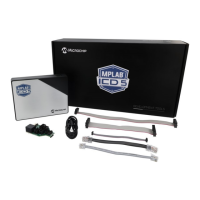Operaon
User Guide
© 2023 Microchip Technology Inc. and its subsidiaries
DS-50003529B - 32
4.3.1.2 nyAVR OCD Features
The tinyAVR OCD for new devices is based on the UPDI physical interface, which is a single pin
programming and debugging interface. It supports the following features:
• Memory-mapped access to device address space (NVM, RAM, I/O)
• No limitation on the device clock frequency
• Unlimited number of user program breakpoints
• Two hardware breakpoints
• Support for advanced OCD features
• Nonintrusive run-time chip monitoring without accessing the system registers
• Interface for reading the result of the CRC check of the Flash on a locked device
The tinyAVR OCD for older devices is based on debugWIRE. For more on OCD features, see
4.3.1.5. debugWIRE OCD Features.
4.3.1.2.1 TinyX-OCD (UPDI) Special Consideraons
The UPDI data pin (UPDI_DATA) can be a dedicated pin or a shared pin, depending on the target
AVR device. A shared UPDI pin will require activation using a High-Voltage (HV) pulse on the UPDI or
RESET pin depending on device. See your device data sheet for details.
On devices which include the CRCSCAN module (Cyclic Redundancy Check Memory Scan), this
module should not be used in Continuous Background mode while debugging. The OCD module
has limited hardware breakpoint comparator resources, so BREAK instructions may be inserted into
Flash (software breakpoints) when more breakpoints are required, or even during source-level code
stepping. The CRC module could incorrectly detect this breakpoint as a corruption of Flash memory
contents.
The CRCSCAN module will appear congured to perform a CRC scan before boot. In the case of a
CRC mismatch, the device will not boot and appears to be in a locked state. The only way to recover
the device from this state is to perform a full chip erase and either program a valid Flash image or
disable the pre-boot CRCSCAN (a simple chip erase will result in a blank Flash with invalid CRC and
the part will thus still not boot). The software front-end will automatically disable the CRCSCAN fuses
when chip erasing a device in this state.
When designing a target application PCB where the UPDI interface will be used, the following
considerations must be made for correct operation:
• Pull-up resistors on the UPDI line must not be smaller than 10 kΩ. A pull-down resistor should
not be used, or it should be removed when using UPDI. The UPDI physical is push-pull capable, so
only a weak pull-up resistor is required to prevent false Start bit triggering when the line is idle.
• If the UPDI pin is to be used as a
RESET pin, any stabilizing capacitor must be disconnected when
using UPDI, since it will interfere with correct operation of the interface.
• If the UPDI pin is used as RESET or GPIO pin, all external drivers on the line must be disconnected
during programming or debugging since they may interfere with the correct operation of the
interface.
4.3.1.2.2 AVR devices with TPI
TPI (Tiny Programming Interface) is present on tinyAVR devices which have no OCD. Debugging of
these devices is not possible - TPI is for programming only.
4.3.1.3 megaAVR OCD Features
The megaAVR OCD is based on the JTAG physical interface. It supports the following features:
• Complete program ow control
• Full access to all registers and memory areas

